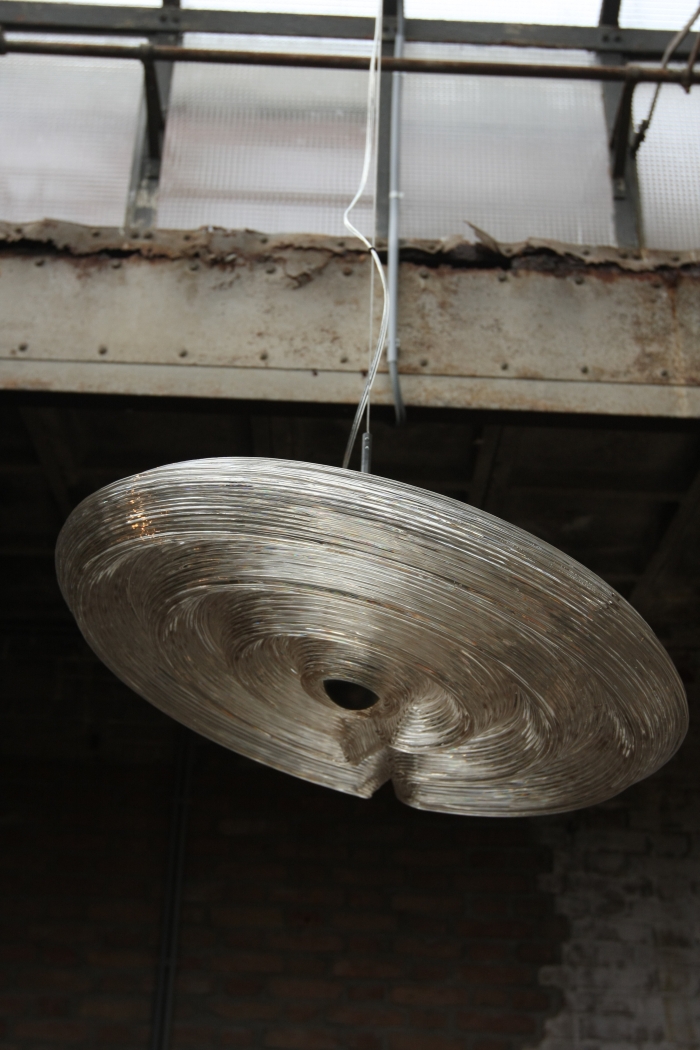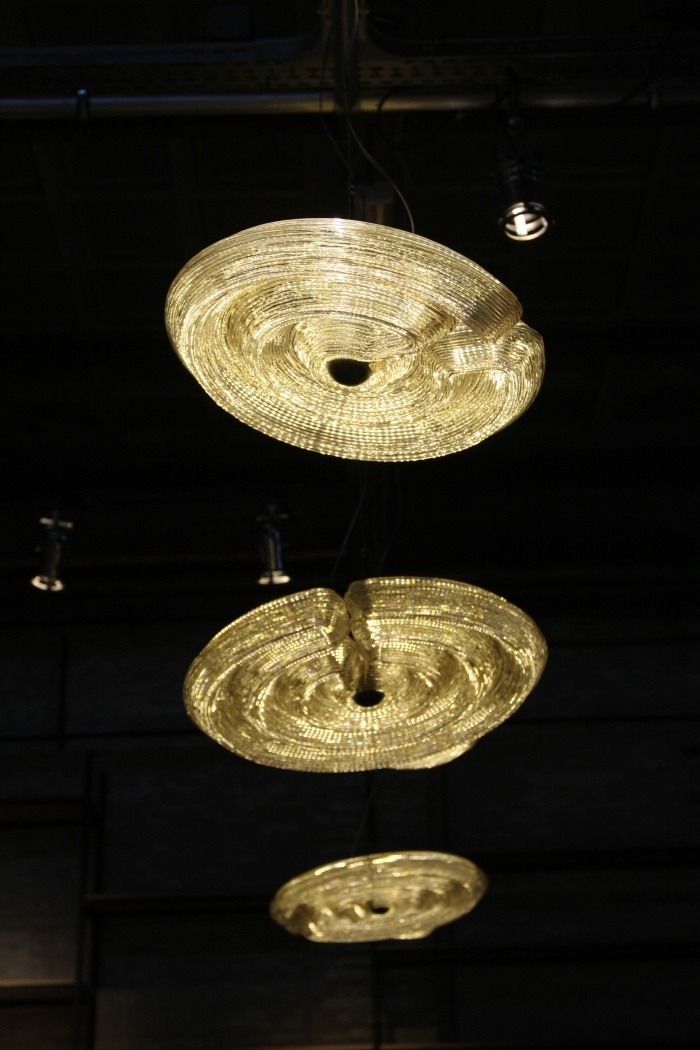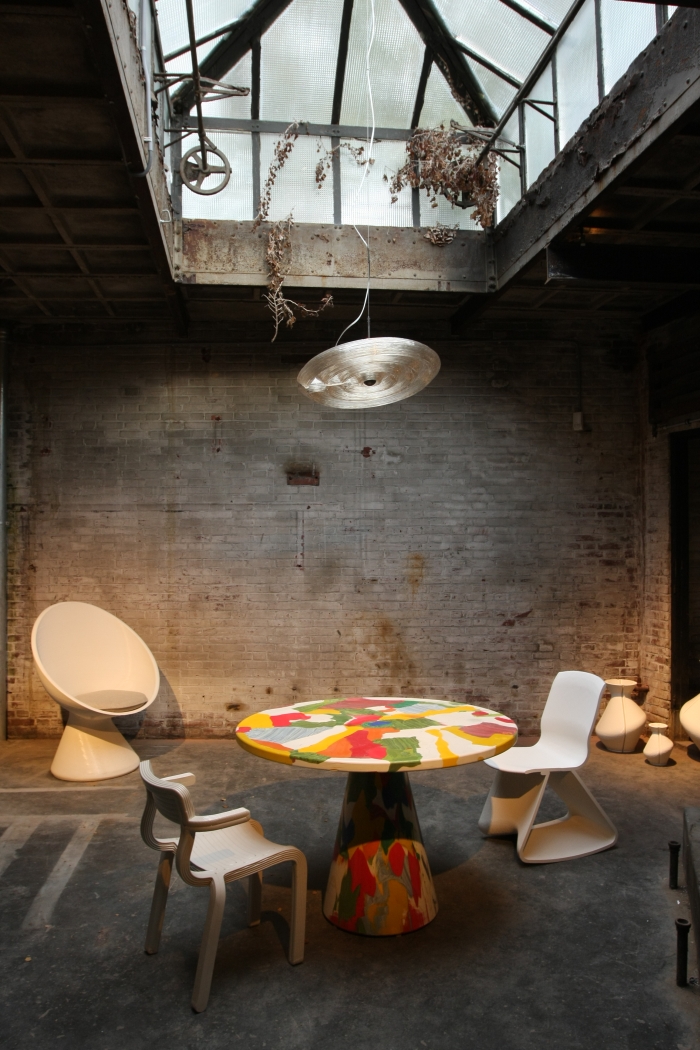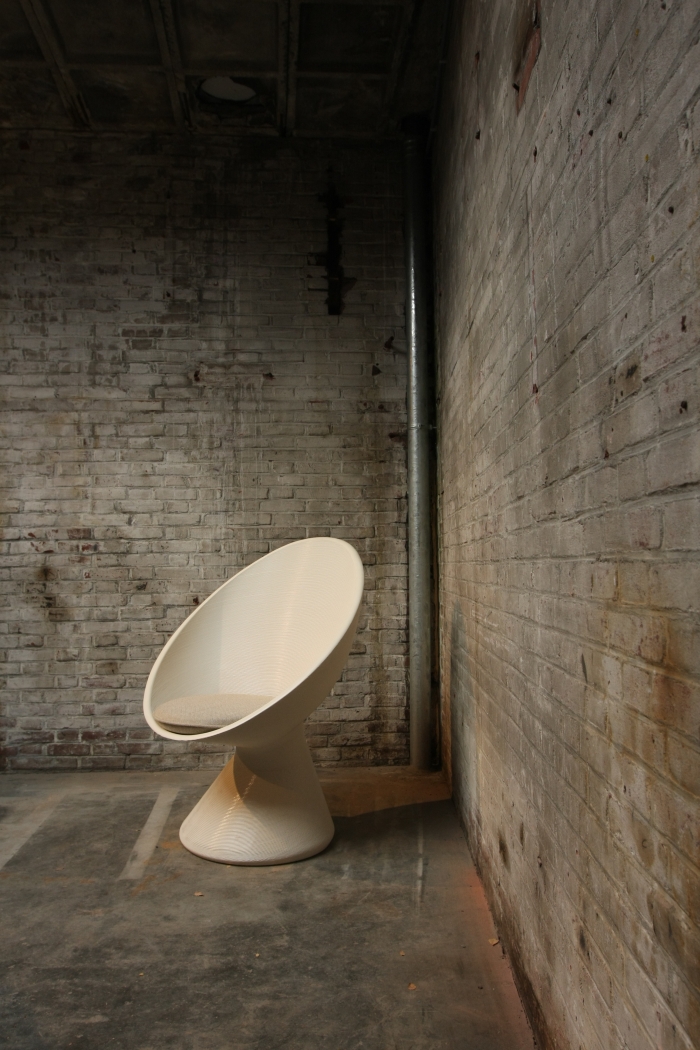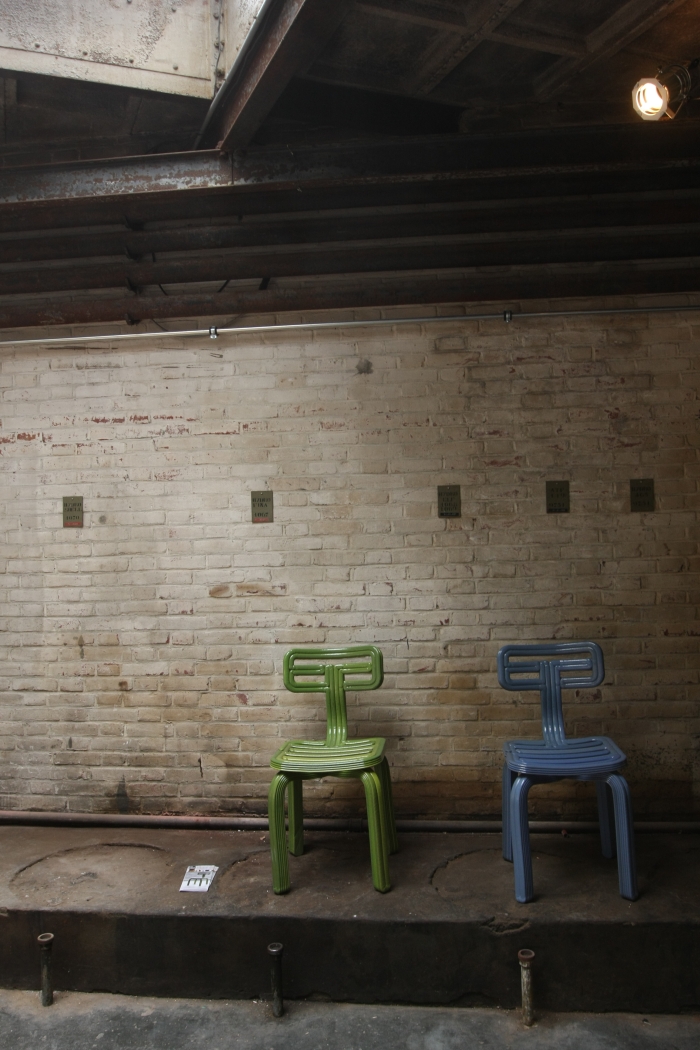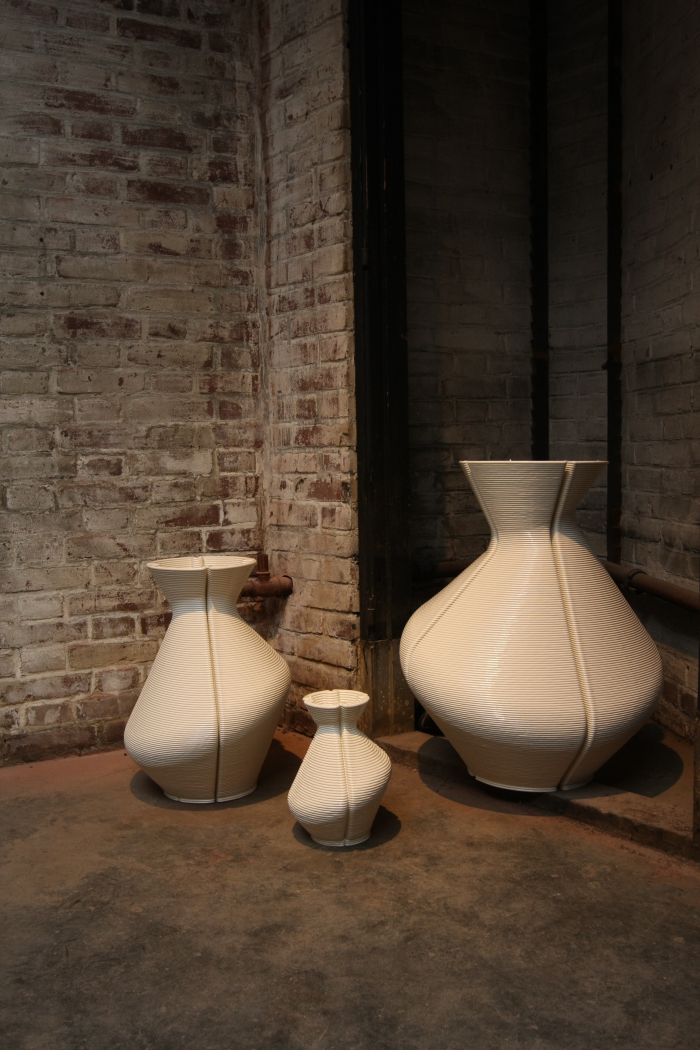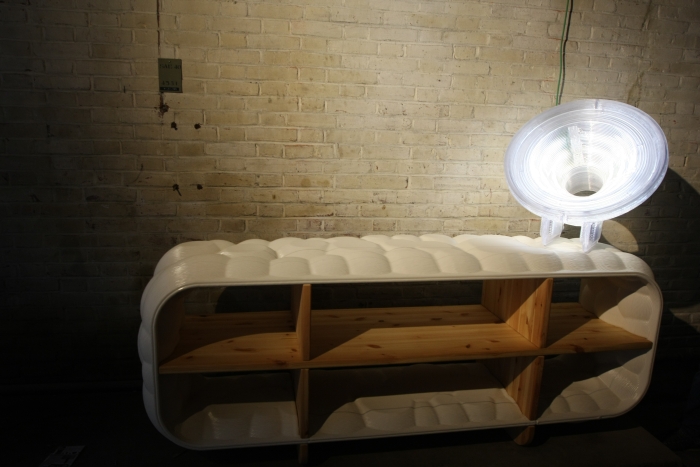(smow) blog compact Dutch Design Week Special: Dirk Vander Kooij
Back in the day when the CD was new and exciting we remember watching a breakfast TV host spread honey on one to demonstrate how indestructible they were. Other CDs were attacked with keys, dowsed in hot coffee and stood on.
These days we all know much better. CDs are destructible. We’ve seen the light.
And at Dutch Design Week 2014 you can can see the light a recycled CD emits.
Or at least the luminescence produced by a mass of recycled CDs in the thoughtfully and intelligently formed Fresnel Suspension Lamp by Dutch designer Dirk Vander Kooij.
Dirk Vander Kooij first made a name for himself with his Design Academy Eindhoven graduation project “Endless”. Superficially a robotic system for 3D printing chairs from plastic salvaged from old fridges, Endless was in many ways much more about developing new production processes; production processes which removed the constraints of conventional industrial production and which allowed the producer to modify, adapt and improve their products in real time without the expense and inconvenience of having to modify or adapt their production process.
Charming, accessible and universally applicable as the first “low resolution” Endless chairs were, it was always clear that Dirk Vander Kooij was going to have to develop and refine his processes if he was to prove the long term value of his ideas.
At Dutch Design Week 2014 Dirk Vander Kooij is presenting a nice selection of older projects and newer developments which indicate that he is moving diligently in that direction.
Products such as the aforementioned Fresnel Suspension Lamp.
“When we first tried to create transparent objects we used new plastic and although we could achieve forms we were happy with, the objects themselves were for me too clear, didn’t emit an especially pleasant, warming, light” explains Dirk. “Then we started experimenting with various recycled materials, and thankfully discovered recycled CDs as they allow us to produce lamps which give off a light with a much more pleasing colour and tint.”
The tint to which Dirk refers is a light golden hue, a light golden hue which is indeed most pleasing on the eye. As is the lamp itself. Formally based on the Fresnel lens, a type of lens perhaps most famously used in lighthouses and which on account of its concentric construction allows for a more concentrated distribution of light than a conventional lens, the Fresnel lamp allows for a uniform 360 degree illumination of this concentrated light while a cup and ball joint allows it to be positioned as required.
The mix of the concentric construction with the 3D printing process and the recycled CDs meanwhile means that the light literally shimmers in the body of the lamp, as if trapped and trying desperately to find a way out. It’s an elegant, if dirty effect, and a lamp which greatly appeals to us.
Aside from experimenting with new materials Dirk Vander Kooij has also spent his time transforming the relatively 2D Endless printing process into a 3D printing process; development work which has not only resulted in a process which allows Dirk to work quicker but has also allowed him to develop new products with new form languages and more complex structures, such as the RVR Chair and Chubby Chair – according to Dirk the first chairs to be printed in three dimensions, a claim we don’t dispute. In addition this development work has also resulted in one of the genuine highlights of Dirk Vander Kooij’s Eindhoven presentation, the Melting Pot Table.
A highlight less because of what it is, but because of what it represents.
Constructed from 40mm thick plastic the Melting Pot Table is both a stable beast – the table top weighs some 50kg, the base 40kg – and a consequent and logical development of Dirk’s commitment to recycling: the Melting Pot Table is composed of old test pieces, failed production pieces and prototypes from the normal production and research processes.
“Over the past four years as we’ve been developing our printing systems we’ve been collecting the waste and refuse”, explains Dirk, “the idea was to create a solid, unbreakable object from this waste. Which we believe we have achieved. This table has now had three lives: it was a fridge, then a chair and now its a table. And will remain a table!”
A delightfully formed table which receives its unique colouration from the mix of waste that is added to each “pot”. And which is also available in a side table version for all wanting something just as indestructible, but less voluminous.
As we’ve often noted in these pages recycling or indeed upcycling is no solution in itself if all it produces is new products which ultimately have to be disposed of. Nor is using “sustainable” materials if they result in disproportionate levels of waste and use disproportionate levels of resources. One of the pioneers of plastic furniture Anna Castelli Ferrieri believed passionately in plastic as a material and believed it was, if properly handled, more sustainable than wood. And she understood that that meant reusing it; consequently she spent a large part of her career working on ways to recycle plastic. But much as the CD is not indestructible so is recycling not a infinite panacea. It’s not, to remain in Dirk Vander Kooij’s vocabulary, Endless. We need alternatives. And so for us the Melting Pot Table is many ways akin to AU Workshop’s candlestick: it doesn’t create a new process to recycle waste, simply re-uses it.
In addition to the Fresnel Suspension Lamp and Melting Pot Table Dirk Vander Kooij’s presentation in Eindhoven features the ever magnificent New Babylon Chair, the Changing Vase, the Satellite Lamp, and the new Soap Cabinet, a sideboard that combines wood with a lightly flowing plastic aesthetic. We can’t claim that we were huge fans of the Soap Cabinet, for us there is something ever so slightly forced about it, for us it lacks the natural ease and formal nonchalance of Dirk’s other works. However having seen the developments Dirk has made since graduating we don’t question for a minute that he knows what he wants to achieve with the project and understands how to realise that.
Following the success with Endless it would have been very easy for Dirk Vander Kooij to have become a one trick designer; to simply create a family of “Endless” products and get fat on the plaudits and commissions. He wouldn’t have been the first. Nor we fear the last. However for Dirk Vander Kooij it has always been about the process as much as the product. About developing new ways of working and so it is to his credit that he has continued to develop and evolve.
His credit and our advantage when one sees the quality of new works on display at Dutch Design Week 2014 and understands the processes, thinking and innovation that led to them. And where they could lead us.
Should you be in Eindhoven Dirk Vander Kooij’s works can be viewed at Kazerne, Paradijslaan 2-8, a.k.a Venue 52
Tagged with: Dirk vander Kooij, Dutch Design week, eindhoven, Fresnel Suspension Lamp, Melting Pot Table
